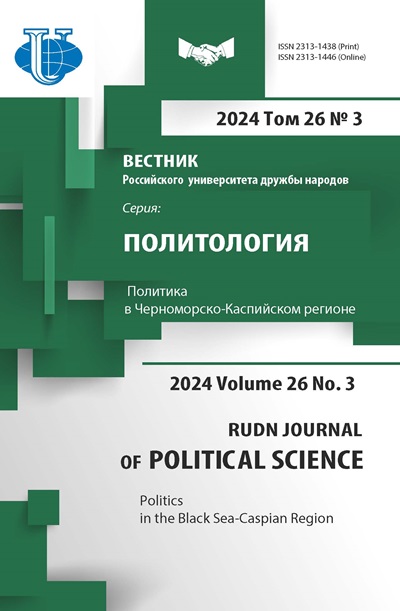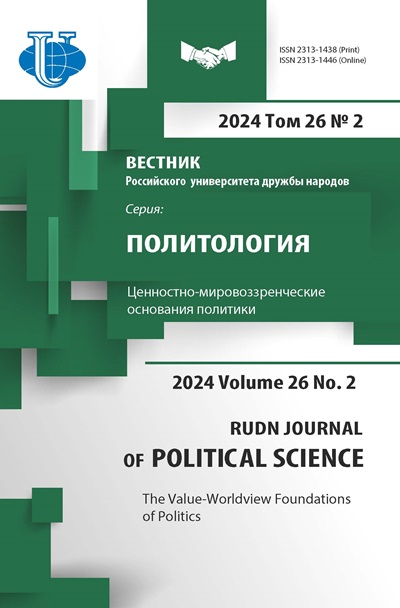Images of “Us” and “Others” as a Factor in the Identification of Citizens in the Context of the Reintegration of the Republic of Crimea and the City of Sevastopol into the Russian Federation
- Authors: Evgenieva T.V.1,2, Smulkina N.V.2
-
Affiliations:
- Financial University under the Government of the Russian Federation
- Lomonosov Moscow State University
- Issue: Vol 26, No 2 (2024): The Value-Worldview Foundations of Politics
- Pages: 292-305
- Section: POLITICAL IDENTITY AND IDENTITY POLICIES: SEMANTIC FOUNDATIONS AND IMPLEMENTATION TOOLS
- URL: https://journals.rudn.ru/political-science/article/view/39756
- DOI: https://doi.org/10.22363/2313-1438-2024-26-2-292-305
- EDN: https://elibrary.ru/NBLJSP
Cite item
Full Text
Abstract
The question of scientific understanding of the features of the Republic of Crimea and the city of Sevastopol reintegration into the sociocultural and identification space of the Russian Federation is relevant from the point of view of using this experience in the integration processes taking place today in new Russian territories. The theoretical approaches of modern Russian and Western authors devoted to the identification side of integration using the example of the formation of the European Union, the reintegration of East and West Germany, as well as the entry of Crimea into the Russian Federation were taken as the conceptual basis for the study. The study relied on a combination of quantitative and qualitative data collection and analysis methods. The applied part was carried out at Sevastopol Federal University. Analysis of the data obtained allowed us to draw several conclusions. There are some multidirectional trends in the formation of the Russian national-state identity of residents of the regions. The majority of residents of the Republic of Crimea and the city of Sevastopol generally identify themselves with Russia and see their regions as part of it. They consider common space, history, culture, and traditions to be the basis for this. They consider these same factors, to a much greater extent than the political or civil components, to be the basis of patriotism. Among these factors, a significant role is played by the memory of historical events of different periods, perceived as part of a single Russian history. At the same time, in the system of spatial and historical images there is a tendency towards a region-centric perception of the country, a desire to highlight and emphasize the special significance of its territory both in history and in the modern space of the Russian Federation. The desire to preserve the unity and cohesion of the peoples of the country, expressed in various forms, became significant. There is some difference here from the results of all-Russian studies - representatives of other nationalities are perceived much more neutrally and calmly than in Russia as a whole. Foreign countries act as “others”, enemies or competitors. At the same time, the images of these countries are poorly specified and reflect the superficial reproduction of media information rather than the result of one’s own understanding of events.
About the authors
Tatiana V. Evgenieva
Financial University under the Government of the Russian Federation; Lomonosov Moscow State University
Author for correspondence.
Email: etv133@mail.ru
ORCID iD: 0000-0002-4711-5476
Candidate of Historical Science, Professor of the Department of Political Science, Faculty of Political Science, Financial University under the Government of the Russian Federation; Associate Professor of the Department of Political Sociology and Psychology, Faculty of Political Science, Lomonosov Moscow State University
Moscow, Russian FederationNatalia V. Smulkina
Lomonosov Moscow State University
Email: smulkina@mail.ru
ORCID iD: 0000-0002-6691-5372
Candidate of Political Science, Associate Professor of the Department of Political Sociology and Psychology, Faculty of Political Science
Moscow, Russian FederationReferences
- Babukhanyan, A.B. (2021). Eurasian civilization: ideology, reintegration, and development. The International Affairs, 12, 38–43. (In Russian).
- Baranov, A.V., & Vasyuk, S.V. (2022). Ethnic and confessional relations as a factor in the ethnopolitical process in Crimea (based on survey materials). Bulletin of Perm University. Political science, 15(4), 88–96. (In Russian). https://doi.org/10.17072/2218-1067-2021-4-88-96
- Belyaev, L.S., Podkovalnikov, S.V., & Chudinova, L.Yu. (2021). Electric power reintegration of Russia with the countries of the Central Asian and Caspian regions. Eurasian integration: Economics, law, politics, 1(35), 32–43. (In Russian). https://doi.org/10.22394/2073-2929-2021-01-32-43
- Creating, Transnational Conditions for Return and Reintegration (2021). Avenir Suisse fifth Annual Think Tank Summit: “Migration Policies towards Refugees and Asylum Seekers and Their Impact on the Labour Market, Social Systems and on National Security”. International Centre for Migration Policy Development.
- Ebzeev, A.A. (2010). Political reintegration: Methodological and theoretical problems. Vlast’, 2, 68–71. (In Russian).
- Egorova, L.G. (2019). Crimean identity in the media picture of the world. Theoretical and Practical Issues of Journalism, 8(2), 373–387. (In Russian). https://doi.org/10.17150/2308-6203.2019.8 (2).373-387.
- Gapizov, Z.R. (2021). Civilizational identity of the population of Crimea as a factor of integration into the Russian space. Public Administration. E-journal (Russia), 85, 189–210. (In Russian). https://doi.org/10.24412/2070-1381-2021-85-189-210
- Garcés-Mascareña, B., & Penninx, R. (Ed.) (2016). Integration processes and policies in Europe. Contexts, Levels and Actors. Springer.
- Hooghe, L., Lenz, T., & Marks, G. (2019). A Theory of International Organization. Oxford: Oxford University Press.
- Karatkevich, A.G. (2009). Reintegration as a factor of sociotransformation and a counterweight to globalization. Ethnosocium and interethnic culture, 5(21), 80–89. (In Russian).
- Kolomiytsev, E.S. (2013). Reintegration of the constituent entities of the Russian Federation in the North Caucasus: Political aspect. Caspian region: politics, economics, culture, 3(36), 359–368. (In Russian).
- Lang, C. (1999). Ostdeutsche Befindlichkeiten ein Jahrzehnt nach der Wende — Ambivalente Spuren des Umbruchs. Wirtschaft im Wandel, 16, 4–9.
- Marks, G. (2012). Europe and its empires: from Rome to the European Union. Journal of Common Market Studies, 50(1), 1–20.
- Mukomel, V.I., & Khaikin, S.R. (2016). Crimean Tatars after the “Crimean Spring”: Transformation of identities. Monitoring of public opinion: economic and social changes, 3, 51–68. (In Russian). https://doi.org/10.14515/monitoring.2016.3.04
- Rosamond, B. (2000). Theories of European Integration. New York : St. Martin’s Press.
- Trufanov, A.Yu. (2018) Reintegration of Crimea into Russia. A view from the province. Scientific notes of the Crimean Federal University named after V.I. Vernadsky. Sociology. Pedagogy. Psychology, 4(70), 258–259. (In Russian).
- Yadransky, D.N. (2018) Group and individual reintegration into Russia: Comparative analysis of life strategies. Scientific notes of the Crimean Federal University named after V.I. Vernadsky. Sociology. Pedagogy. Psychology, 4(70), S2, 325–330. (In Russian).
- Yanchuk, V.A. (2019) Reintegration of the Republic of Belarus and the Russian Federation into the Union State: stages and contradictions of political and economic interaction. Law. Economy. Psychology, 2(14), 60–68. (In Russian).
















